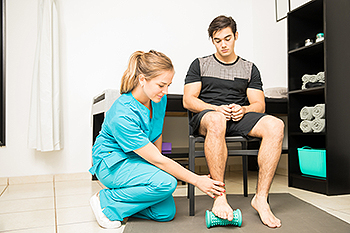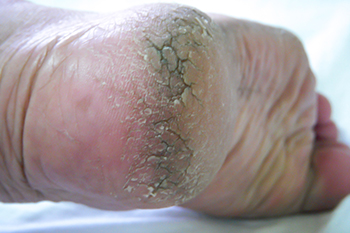Items filtered by date: October 2022
The Plantar Fascia and Plantar Fasciitis

The plantar fascia is a band of tissue that is found on the sole of the foot, and it connects the toes to the heel. When the plantar fascia becomes inflamed, plantar fasciitis can develop. Causes of plantar fasciitis may include frequently participating in running and jumping activities, wearing shoes that do not fit correctly, and sustaining a foot injury. Standing on hard surfaces for most of the day may also contribute to the development of plantar fasciitis. This condition may happen gradually or suddenly, but this depends on the cause of the inflamed plantar fascia. The heel pain associated may be controlled by maintaining a healthy weight, wearing shoes that support the arch, and performing stretches that can help to strengthen the entire foot. If you have heel pain, it is strongly advised that you are under the care of a podiatrist who can effectively treat plantar fasciitis.
Plantar fasciitis is a common foot condition that is often caused by a strain injury. If you are experiencing heel pain or symptoms of plantar fasciitis, contact one of our podiatrists from Podiatry Associates of Victoria. Our doctors can provide the care you need to keep you pain-free and on your feet.
What Is Plantar Fasciitis?
Plantar fasciitis is one of the most common causes of heel pain. The plantar fascia is a ligament that connects your heel to the front of your foot. When this ligament becomes inflamed, plantar fasciitis is the result. If you have plantar fasciitis you will have a stabbing pain that usually occurs with your first steps in the morning. As the day progresses and you walk around more, this pain will start to disappear, but it will return after long periods of standing or sitting.
What Causes Plantar Fasciitis?
- Excessive running
- Having high arches in your feet
- Other foot issues such as flat feet
- Pregnancy (due to the sudden weight gain)
- Being on your feet very often
There are some risk factors that may make you more likely to develop plantar fasciitis compared to others. The condition most commonly affects adults between the ages of 40 and 60. It also tends to affect people who are obese because the extra pounds result in extra stress being placed on the plantar fascia.
Prevention
- Take good care of your feet – Wear shoes that have good arch support and heel cushioning.
- Maintain a healthy weight
- If you are a runner, alternate running with other sports that won’t cause heel pain
There are a variety of treatment options available for plantar fasciitis along with the pain that accompanies it. Additionally, physical therapy is a very important component in the treatment process. It is important that you meet with your podiatrist to determine which treatment option is best for you.
If you have any questions, please feel free to contact our office located in Victoria, TX . We offer the newest diagnostic and treatment technologies for all your foot care needs.
Pain Between the Toes May Indicate Morton’s Neuroma

There is a foot condition that can affect the nerves between the third and fourth toes which is known as Morton’s neuroma. If prompt treatment is not received, it can cause severe pain and discomfort. This foot condition can occur as a result of wearing shoes that are too tight in the toe area. An example of these types of shoes is high heels, and the higher the heel is, the pointier the shoe can be. Pain in this area of the foot will often bring a patient into a podiatrist’s office, where a proper diagnosis can be performed. This often includes a physical examination, in addition to having X-rays taken, and an MRI or ultrasound may be necessary for further confirmation. In the beginning stages, relief may be found when larger shoes are worn, and the heel size is reduced. In severe cases, surgery may be necessary to remove or repair the affected nerves, which can accelerate the healing process. If you have pain between your toes, please schedule an appointment with a podiatrist who can provide the treatment that is best for you.
Morton’s neuroma is a very uncomfortable condition to live with. If you think you have Morton’s neuroma, contact one of our podiatrists of Podiatry Associates of Victoria. Our doctors will attend to all of your foot care needs and answer any of your related questions.
Morton’s Neuroma
Morton's neuroma is a painful foot condition that commonly affects the areas between the second and third or third and fourth toe, although other areas of the foot are also susceptible. Morton’s neuroma is caused by an inflamed nerve in the foot that is being squeezed and aggravated by surrounding bones.
What Increases the Chances of Having Morton’s Neuroma?
- Ill-fitting high heels or shoes that add pressure to the toe or foot
- Jogging, running or any sport that involves constant impact to the foot
- Flat feet, bunions, and any other foot deformities
Morton’s neuroma is a very treatable condition. Orthotics and shoe inserts can often be used to alleviate the pain on the forefront of the feet. In more severe cases, corticosteroids can also be prescribed. In order to figure out the best treatment for your neuroma, it’s recommended to seek the care of a podiatrist who can diagnose your condition and provide different treatment options.
If you have any questions, please feel free to contact our office located in Victoria, TX . We offer the newest diagnostic and treatment technologies for all your foot care needs.
Heel Pain Can Be Treated!
Pregnancy and Foot Numbness

If you are thinking about becoming pregnant, you ought to know that your feet will experience a number of important changes as a result of your pregnancy. For example, in addition to experiencing possible swelling and enlargement, you might experience numbness in the feet during pregnancy. This is due to the fact that nerves in the legs can experience pressure when the uterus grows. As a result, a pregnant woman may have feelings of numbness in the toes. Some individuals will even describe this feeling as a kind of “pins and needles” sensation in the feet. A number of women experience this kind of numbness in their feet during the pregnancy, and fortunately, the feelings should subside after the pregnancy. If pregnancy is something you anticipate in your future, it might be a good idea to contact a podiatrist to discuss ways you can maintain healthy feet throughout the process.
Pregnant women with swollen feet can be treated with a variety of different methods that are readily available. For more information about other cures for swollen feet during pregnancy, consult with one of our podiatrists from Podiatry Associates of Victoria. Our doctors will attend to all of your foot and ankle needs.
What Foot Problems Can Arise During Pregnancy?
One problem that can occur is overpronation, which occurs when the arch of the foot flattens and tends to roll inward. This can cause pain and discomfort in your heels while you’re walking or even just standing up, trying to support your baby.
Another problem is edema, or swelling in the extremities. This often affects the feet during pregnancy but tends to occur in the later stages.
How Can I Keep My Feet Healthy During Pregnancy?
- Wearing orthotics can provide extra support for the feet and help distribute weight evenly
- Minimize the amount of time spent walking barefoot
- Wear shoes with good arch support
- Wear shoes that allow for good circulation to the feet
- Elevate feet if you experience swelling
- Massage your feet
- Get regular, light exercise, such as walking, to promote blood circulation to the feet
If you have any questions please feel free to contact our office located in Victoria, TX . We offer the newest diagnostic and treatment technologies for all your foot and ankle needs.
Cracked Heels Can Be Painful

Severely cracked heels are referred to as fissures. They can develop from having dry skin on the heels of the feet and can cause pain and discomfort. In severe cases, they may begin to bleed even become infected. Cracked heels can develop from wearing shoes that are backless, or from standing on hard surfaces for extended periods of time throughout the day. Additional reasons may include medical conditions, consisting of psoriasis and eczema. The medical term for dry skin is xerosis, and is the most common reason for cracked heels to develop. Obesity may also contribute significantly to having this ailment because of the extra weight the heels have to endure. If you have cracked heels, it is strongly urged that you consult with a podiatrist who can determine what the cause is, and offer correct treatment methods for permanent relief.
If the skin on your feet starts to crack, you may want to see a podiatrist to find treatment. If you have any concerns, contact one of our podiatrists from Podiatry Associates of Victoria. Our doctors can provide the care you need to keep you pain-free and on your feet.
Cracked Heels
It is important to moisturize your cracked heels in order to prevent pain, bleeding, and infection. The reason cracked heels form is because the skin on the foot is too dry to support the immense pressure placed on them. When the foot expands, the dry skin on the foot begins to split.
Ways to Help Heal Them
- Invest in a good foot cream
- Try Using Petroleum Jelly
- Ease up on Soaps
- Drink Plenty of Water
Ways to Prevent Cracked Heels
- Moisturize After Showering
- Skip a Shower
- Keep Shower Water Lukewarm
- Don’t Scrub Your Feet
If you are unsure how to proceed in treating cracked heels, seek guidance from a podiatrist. Your doctor will help you with any questions or information you may need.
If you have any questions, please feel free to contact our office located in Victoria, TX . We offer the newest diagnostic and treatment technologies for all your foot care needs.

